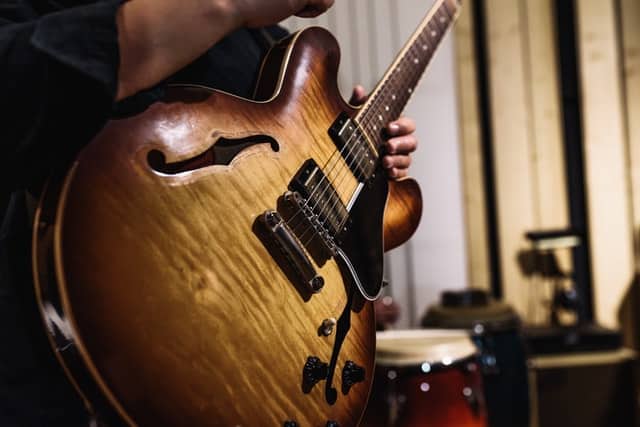Whether you want to sell a guitar directly or to a shop, there’s usually a bit of work to be done first.
If the presentation of your instrument is stunning you should be able to get a better price too so you can think of your time as an investment.
As long as there is no major cosmetic damage you may be able to change an instrument from acceptable condition to good or even excellent.
How much you do is up to you but this should give you some ideas to consider.
Testing, cleaning, gathering accessories, and taking quality photographs of your guitar before selling it should be considered the bare minimum. If you plan on selling more guitars in the future then you probably want to go a step beyond to earn a good seller reputation. And try to treat buyers as you would want to be treated.
Some of the things we will cover here require some supplies so you may wish to skip them if you don’t want to spend any money.
But they are nice to have around for other instruments and electronics so I think they are worth it in the long run.
Let’s get started on the recommended practices to ensure a good sale.
7 things you should do before selling your guitar
1. Testing
Before you can sell a guitar you have to make sure that everything works as it should or at least be able to say if something doesn’t work (“sold as is”).
This one really isn’t negotiable. Check each pickup and combination of pickups.
Check each control knob and the input jack as well. Make sure that the input jack isn’t loose and repair it if needed. And if the guitar has any active electronics try each setting.
2. Cleaning
At the very least you should wipe down the guitar with a proper cloth and use polish if you have any.
I have found that a cotton swab can be useful for getting dust in areas around the bridge, pickups, and tuners.
If your input jack or controls are scratchy the knobs can be removed and the potentiometers can be cleaned with a spritz of DeoxIT D5 contact cleaner.
It is pretty expensive but it works wonders and can be used on amplifiers as well so it’s a good investment.
3. Strings
Whether you should replace the strings really depends on how old they are.
If they are pretty new then you don’t have to spend the money. If you do replace the strings though, you may want to consider cleaning the (ebony/rosewood) fretboard with a fretboard conditioner/oil.
I have used Dunlop and Fender brands and I recommend Dunlop’s Fretboard 65 lemon oil.
This will make a big difference in the appearance and give some shine to it for photos.
If you take the time to do it you can mention it as a selling point.
You never know, the fretboard might look so nice that you’ll decide not to get rid of the guitar after all.
4. Setup
If you are trying to sell a very high-end instrument you will have to decide whether to pay for a guitar setup or not, if you can’t do it yourself.
Or if you play extremely heavy or light gauge strings and the guitar was designed for something in the middle you might want to put the manufacturer’s suggested string gauge back on and you then may need a minor setup or truss rod adjustment.
And if the guitar has been tweaked for really low action or something you may want to at least mention that if you don’t return it to the manufacturer’s specifications.
5. Originality
Your best bet to get what your guitar is worth is to make/keep it as original as possible.
If you or previous owners modified the guitar and you still have the original parts you should make the instrument as close to what it was when it left the factory as you can.
Remember that what you think of as upgrades may not be appealing to someone else, especially if you drilled holes in the wood.
And if you did something extreme like scalloping the fretboard you are going to have a hard time finding a buyer.
6. Accessories
Any accessories that came with the instrument should be included.
Things to consider are the original case or gig bag, tremolo arm, truss rod adjustment tool, the cover for the tremolo cavity, paperwork, case candy, etc.
7. Photographs
If you are selling your guitar online you should provide high-quality pictures of at least the front and back of the guitar.
If you have a case you can take a picture of the guitar with the case too.
And if there is any damage or modifications to the guitar it is better to show them before the buyer decides to purchase it so there are no surprises later.
Should you really worry about all of these things before selling your guitar?
How much time and money you want to put into your sale is up to you but at least test and moderately clean the guitar, gather all the accessories, and make an effort when you take the photos.
If you are only selling one instrument or a few you don’t really need to worry about your “reputation” or seller rating but if you plan on selling a lot of things then positive feedback is important.
And if someone wants to bargain with you and gives a low offer you can be firmer with your price because of the work you did to get the guitar in great condition.
Finally, these things are just good business habits to practice. You should try to be a seller that you would want to deal with if you were buying. People will appreciate it.
If you are thinking of selling your guitar
Once you have your guitar sparkling it is time to decide how you are going to sell it.
If convenience is paramount you can simply sell to a store that buys used gear or takes it as a trade-in.
But you won’t get the maximum profit that way and if you did a lot of work to prepare your instrument to sell you deserve to be rewarded.
These days selling via online platforms is very popular but keep in mind that you’re going to lose a fair percentage in fees with most websites.
Here are some of the best places to sell your guitar online.
Whatever you decide to do just remember to practice good communication with your buyers and good luck!

Hello there, my name is Ramiro and I’ve been playing guitar for almost 20 years. I’m obsessed with everything gear-related and I thought it might be worth sharing it. From guitars, pedals, amps, and synths to studio gear and production tips, I hope you find what I post here useful, and I’ll try my best to keep it entertaining also.





